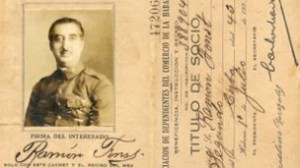It was when it started the Olympic history of Latin America. More than a century, in 1900, a Cuban fencer only 17 years old in Paris got the first gold medal for the region. His name, Ramon Fonst.
Young and elegant, Fonst repeated his gold foil and épée four years later, this time in the U.S., showing that in their victories there was nothing fortuitous.
He came from a wealthy family who sent him, still just a child, to study in France, where he studied with a large Master at Arms. However, to receive the medal called the Cuban flag hoisted, but the island was still a Spanish colony.
The tradition became entrenched for decades and benefited from the impetus provided by the sport after 1959. The fencing had such force that recovered after the death of all the youth team in an attack on an airplane in 1976.
Just 15 years after the Cuban Rolando Tucker became the first black person to champion. Despite this tradition could be in danger, in London there will be no Cuban fencing team, something that only happened in 1928 and 1956.
“Fencer fascinating”
Irene Forbes joined the Cuban fencing for 10 years after leaving high performance sport became a sports journalist and published several books including a biography of Ramon Fonst, who won the national award.
 Irene Forbes, exesgrimista cubana, escribió una biografía de Ramón Fonst.
Irene Forbes, exesgrimista cubana, escribió una biografía de Ramón Fonst.
He told BBC News that his interest arose because Fonst “I found the coach was Roger de Lauria, his comrade in arms. I always spoke of him and at the end of my time as a fencer myself I started researching his life.”
Lauria told him that “when there was no foil or electric sword, but it is inking the tip of the weapon button, in the suit were the marked points and Ramon Fonst competition ended always immaculate.”
At 8 he was sent to France, “and at 15 start having results in European events until there is fencing in 1900 at the Olympics in Paris. Was a fencer fascinating, a very large stature, but threw more ambidextrous left-handed. ”
Clinging to his roots
Forbes explains why Ramon Fonst go very deep to the Cubans: “In 1900 we were still yet we appear colony in the annals of history with our first Olympic medal and first hoisted the flag of Cuba in the Olympics.”
Fonst not forget the remote island of his birth. “In 1904 the Olympic Committee asked permission to form a team that was not entirely Cuban Americans participated friends. It was actually an international team, but was called Cuba”.
 Fonst abrió el camino para el exitoso paso de Cuba por los Juegos Olímpicos.
Fonst abrió el camino para el exitoso paso de Cuba por los Juegos Olímpicos.
After winning his first Olympic medal back to the island, where he was received with honors by his countrymen, surprised by an adolescent who repeatedly emphasized his status as a Cuban, even before the country existed as such.
For the rest of his life training in the armory of the family farm. Continues to compete officially until 1938, when at age 55 participates in the Central American Games in Panama. At 72 makes its last exhibition shooting.
The End of a dream
Ramon Fonst was an athlete off the charts but was not as successful as a coach. For decades Cuba scored only in regional games, “the first worldwide is in 86, a silver medal in men’s foil for Tulio Diaz in Bulgaria”.
Forbes notes that “then came the golden age, the emergence Elvis Gregory, Tucker and Oscar Rolando Garcia, the trick that took silver medal in Barcelona and Ivan Trevejo also takes Olympic silver in Atlanta 1996.”
“The decline of fencing (in Cuba) has been dizzying”
But in recent years “the decline of fencing has been dizzying,” says Forbes and remember not to go Cuban fencers London Olympics. The fall is due to the lack of financial resources to support a very expensive sport.
In addition to expensive equipment, it is difficult to predict which athletes will perform well, “until you have practiced 6 or 7 years can not know. Have to invest a lot before picking, and not knowing if you should pick up.”
Anyway Forbes thinks you should keep investing in fencing rather than devote to activities “where we have never achieved anything. I think the money you have to be invested in sports that historically have proved true.”
Sources: First Gold/ FernandoRavsberg/BBC/Uk/InternetPhotos/TheCubanHistory.com
Londres 2012 el primer oro/ The Cuban History/ Arnoldo Varona, Editor
LA PRIMERA MEDALLA DE ORO OLIMPICA A LATINOAMERICANA FUE A CUBA
Fue cuando comenzó la historia olímpica de América Latina. Hace más de un siglo, en 1900, un esgrimista cubano de sólo 17 años consiguió en París la primera medalla de oro para la región. Su nombre, Ramón Fonst.
Joven y elegante, Fonst repitió su oro en florete y espada cuatro años más tarde, esta vez en Estados Unidos, demostrando que en sus victorias no había nada fortuito.
Provenía de una acaudalada familia que lo envió, siendo apenas un niño, a estudiar a Francia, donde fue alumno de un importante Maestro de Armas. Sin embargo, al recibir la medalla pidió que se izara la bandera cubana, aunque la isla era todavía colonia española.
La tradición se afianzó durante décadas y se benefició del impulso que recibió el deporte después de 1959. La esgrima tuvo tanta fuerza que se recuperó después de la muerte de todo el equipo juvenil en un atentado contra un avión en 1976.
Apenas 15 años después el cubano Rolando Túcker se convertía en la primera persona de raza negra campeón mundial. A pesar de todo esto la tradición podría estar en peligro, en Londres no habrá equipo cubano de esgrima, algo que solo había ocurrido en 1928 y 1956.
“Esgrimista fascinante”
Irene Forbes integró la selección cubana de esgrima durante 10 años, tras dejar el deporte de alto rendimiento se hizo periodista deportiva y publicó varios libros, entre ellos una biografía de Ramón Fonst, que ganó el premio nacional.
 Irene Forbes, exesgrimista cubana, escribió una biografía de Ramón Fonst.
Irene Forbes, exesgrimista cubana, escribió una biografía de Ramón Fonst.
Explicó a BBC Mundo que su interés por Fonst surgió porque “el entrenador que me descubrió fue Roger de Lauria, su compañero de armas. Siempre me hablaba de él y en las postrimerías de mi etapa como esgrimista yo misma empecé a investigar su vida”.
De Lauria le contaba que “cuando todavía no existía el florete o la espada eléctrica, si no que se entintaba la punta del botón del arma, se veían en el traje los puntos marcados y el de Ramón Fonst terminaba la competencia siempre inmaculado”.
A los 8 años fue enviado a Francia y “ya a los 15 empieza a tener resultados en eventos europeos de esgrima hasta que se presenta en 1900 en las olimpiadas de París. Fue un esgrimista fascinante, una estatura muy grande, ambidiestro pero que tiraba más a la zurda”.
Aferrado a sus raíces
Forbes explica porqué Ramón Fonst llega muy hondo a los cubanos: “En 1900 aun éramos colonia y sin embargo aparecemos en los anales de la historia olímpica con nuestra primera medalla y se izó por primera vez la bandera de Cuba en una olimpiada”.
Fonst no olvidaba la lejana isla donde nació. “En 1904 le pide al comité olímpico autorización para formar un equipo que no era enteramente cubano, participaron también americanos amigos suyos. En realidad era un equipo internacional, pero se llamó Cuba”.
 Fonst abrió el camino para el exitoso paso de Cuba por los Juegos Olímpicos.
Fonst abrió el camino para el exitoso paso de Cuba por los Juegos Olímpicos.
Tras ganar su primera medalla olímpica regresa a la isla, donde es recibido con todos los honores por parte de sus compatriotas, sorprendidos por aquel adolescente que resaltaba una y otra vez su condición de cubano, aun antes de que el país existiera como tal.
Durante el resto de su vida entrena en la sala de armas de la finca familiar. Continúa compitiendo oficialmente hasta 1938, cuando a los 55 años participa en los Juegos Centroamericanos de Panamá. A los 72 años realiza su última exhibición de tiro.
¿El fin de un sueño?
Ramón Fonst fue un deportista fuera de serie pero no tuvo tanto éxito como entrenador. Durante décadas Cuba solo obtuvo resultados en juegos regionales, “el primero a nivel mundial es en el 86, una medalla de plata en florete masculino para Tulio Díaz en Bulgaria”.
Forbes señala que “después vino la época de oro, al surgir Elvis Grégory, Rolando Túcker y Oscar García, esa tripleta que cogieron medalla de plata en Barcelona e Iván Trevejo que también coge medalla de plata olímpica en Atlanta 1996”.
“El descenso de la esgrima (en Cuba) ha sido vertiginoso”
Pero durante los últimos años “el descenso de la esgrima ha sido vertiginoso”, dice Forbes y recuerda que no irán esgrimistas cubanos a la olimpiada de Londres. La caída se debe a la falta de recursos económicos para sustentar un deporte muy caro.
Además de lo costoso del equipamiento, es difícil prever qué deportistas tendrán buenos resultados, “hasta que usted no tiene 6 o 7 años practicados no se puede saber. Hay que invertir mucho antes de recoger, y sin saber si va a poder recoger”.
De todas formas Forbes cree que se debería seguir invirtiendo en la esgrima en vez de dedicarlo a actividades “donde nunca hemos conseguido nada. Yo pienso que el dinero que haya debe invertirse en los deportes que de verdad han dado resultados históricamente”.
Sources: First Gold/ FernandoRavsberg/BBC/Uk/InternetPhotos/TheCubanHistory.com
Londres 2012 el primer oro/ The Cuban History/ Arnoldo Varona, Editor




